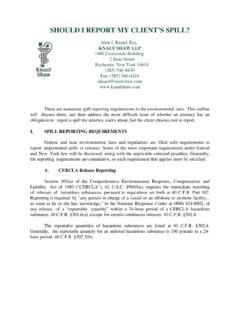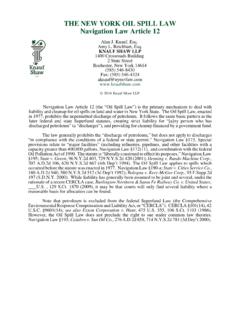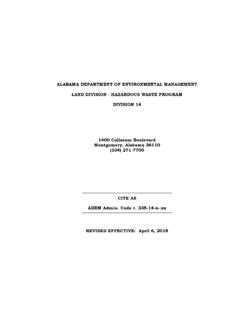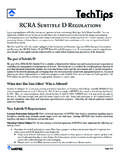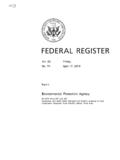Transcription of Chapter VI SOLID WASTE REGULATION - Knauf Shaw LLP
1 Chapter VI. SOLID WASTE REGULATION . SOLID WASTE is defined as follows: The term SOLID WASTE means any garbage, refuse, sludge from a WASTE treatment plant, water supply treatment plant, or air pollution control facility and other discarded material, including SOLID , liquid, semisolid, or contained gaseous material resulting from industrial, commercial, mining, and agricultural operations, and from community activities, but does not include SOLID or dissolved material in domestic sewage, or SOLID or dissolved materials in irrigation return flows or industrial discharges which are point sources subject to permits under section 1342 of title 33, or source, special nuclear, or byproduct material as defined by the Atomic Energy Act of 1954, as amended. Resource Conservation and Recovery Act of 1976 ( RCRA ) 1004(27), 42 6904(27);. see also NY ECL 27-0701(1). SOLID WASTE is governed both by RCRA, and regulatory programs under state law. A. FEDERAL REGULATION . Subtitle D of RCRA, 42 6941-6949a, addresses SOLID WASTE on the federal level.
2 RCRA 4004, 42 6944, requires EPA to promulgate regulations differentiating between open dumps and sanitary landfills, and setting criteria for sanitary landfills. RCRA 4005, 42 6945, requires that all open dumps be closed or upgraded. Further, RCRA requires federal guidelines for state SOLID WASTE plans, 4002, 4003, 42 6942, 6943, as well as a procedure for development, 4006, 42 6946, and approval, 4007, 42 6947, of such plans. Once such a plan is approved, a state becomes eligible for federal financial assistance. 4007(b), 4008, 42 6947(b), 6948. While federal REGULATION was formerly in the background, on October 9, 1993, EPA. regulations promulgated under RCRA, set forth at 40 CFR Part 258, became effective to govern all privately and publicly-owned municipal SOLID WASTE landfill ( MSWLF ) units. MSWLF. units must now meet a variety of location restrictions, set forth in Subpart B of Part 258, related to airport safety, flood plains, wetlands, fault areas, seismic impact zones, and unstable areas.
3 Further, MSWLF units must meet operating criteria set forth in Subpart C concerning procedures for excluding hazardous wastes, cover material requirements, disease vector and explosive gases control, air pollution criteria (including a ban on open burning), access requirements, run-on/run- off control, surface water discharge limitations, liquids restrictions, and recordkeeping. All new MSWLF units and lateral expansions are now required to have a composite liner and leachate collection system, or else meet other approved design criteria. Part 258, Subpart D. Further, specific requirements for Groundwater Monitoring and Corrective Action, Subpart E, Closure and Post-Closure, Subpart F, and Financial Assurance, Subpart G, are specified. These federal regulations are self-implementing, but they do not appear to preempt existing state regulations and permit systems that do not conflict, or are stricter. However, states can be delegated authority over the program.
4 Landfills that accept less than 20 tons of WASTE per day (on an annual basis) can qualify for exemptions from some requirements. 40 (f)(1). Furthermore, the Commerce Clause of the Constitution provides limitations on the abilities of states and local governments to limit the source of SOLID WASTE that may be accepted by SOLID WASTE management facilities. Thus, a state or local government cannot prohibit a private facility from accepting garbage from out-of-state or other areas of the state, unless perhaps it is of a different character than other WASTE . Fort Gratiot Sanitary Landfill, Inc. v. Michigan Department of Natural Resources, 504 353, 112 2019 (1992). Nor can this be 2. accomplished by a taxing scheme that discriminates against out-of-state WASTE . Chemical WASTE Management, Inc. v. Hunt, 504 334, 112 2009 (1992); Oregon WASTE Systems, Inc. v. Department of Environmental Quality of State of Oregon, 511 93, 114 1345 (1994). Further, states cannot adopt flow control rules that require private parties to only bring garbage to a particular facility.
5 C & A Carbone, Inc. v. Town of Clarkstown, New York, 511 383, 114 1677 (1994). However, a public authority which operates its own facility probably can restrict the source of the garbage it accepts to sources within its own territorial limits within the state, and make exclusive contracts to dispose of the WASTE that the municipality collects. SSC. Corp. v. Town of Smithtown, 66 502 (2d Cir. 1995), cert den'd 516 1112, 116 911 (1996). B. NEW YORK STATE POLICY. In the mid to late 1980's, largely due to the Mobro garbage barge incident in 1987, awareness grew that existing landfills were environmentally inadequate, and that New York State lacked the capacity to handle the SOLID WASTE that would be generated by its residents. Against this background, DEC first issued the New York State SOLID WASTE Management Plan (the Plan ) in 1987, as contemplated by RCRA Subtitle D and ECL 27-0103. It is updated annually. The Plan called for rapid movement from landfilling to an integrated SOLID WASTE management program, treating SOLID WASTE as a resource to be recovered to the extent technically feasible.
6 The Plan adopted a SOLID WASTE management hierarchy (the Hierarchy ) consisting, in order of preference, of: (1) WASTE Reduction (2) Reuse and Recycling 3. (3) WASTE to Energy (4) Landfilling. The Plan called for a 50% reduction in the SOLID WASTE stream over the next 10 years, to be accomplished by reduction of WASTE (8-10%) by changing the way goods are manufactured, particularly by federal and state restrictions on packaging, and recycling and reuse (40-42%), to be accomplished primarily by local municipalities. The remaining 50% would be processed in resource recovery/ WASTE -to-energy plants to further reduce volume and produce energy, and the balance, consisting primarily of plant residue and unprocessable materials, would then be landfilled. Thus, the Plan was to substantially reduce the reliance upon landfilling. At the same time as it was developing the Plan, DEC embarked upon a course to close most of the 294. operating landfills in the state, almost all of which were operating without current permits.
7 The State Legislature began implementing the basic goals of the Plan through the SOLID WASTE Management Act of 1988. Among other things, the law specifically adopted the Hierarchy as the official policy of the state in ECL 27-0106(1), which provides: The following are the SOLID WASTE management priorities in this state: (a) first, to reduce the amount of SOLID WASTE generated;. (b) second, to reuse material for the purpose for which it was originally intended or to recycle material that cannot be reused;. (c) third, to recover, in an environmentally acceptable manner, energy from SOLID WASTE that can not be economically and technically reused or recycled;. and (d) fourth, to dispose of SOLID WASTE that is not being reused, recycled or from which energy is not being 4. recovered, by land burial or other methods approved by the department. The law also called for a state-local partnership, in which the basic responsibilities for the planning and operating of SOLID WASTE management facilities remaining with local governments and the state provides necessary guidelines and assistance.
8 27-0106(2). Thus, the Act provided for local SOLID WASTE management plans, which would be put together by a local planning unit (defined as a county, two or more counties, acting jointly, a local government or or two or more ), and would set forth the strategy for the locality to comply with the Hierarchy. ECL 27-0107. The local plans must include a comprehensive recycling analysis, as well as a description of the facilities, laws and initiatives necessary to carry out the program. No application for a state permit for a SOLID WASTE management facility is complete unless the facility is consistent with the Hierarchy. ECL 27-0707(2)(a). Moreover, no such application by a municipality is complete without a local SOLID WASTE management plan. 27- 0707(2)(b). Furthermore, all municipalities are now required to have in effect a local law that mandates source separating of materials for which economic markets for alternative uses exist.. General Municipal Law 120-aa(2)(a).
9 Economic markets are defined on an avoided costs . basis, so that the local law must require source separation and recycling of a category of materials if the net cost of collection, transport and recycling or reuse is less than or equal to the cost of collection, transportation and disposal. Further, a Bureau of WASTE Reduction and Recycling was established within DEC. ECL. 27-0717. Among other things, it is changed with authority to set regulatory standards for use of the terms recycled, recyclable and reusable, and the official state emblem for these terms. 5. Limited funding is provided for local SOLID WASTE plans and recycling programs. ECL 27- 0109, 27-0405. Under Article 54 of the ECL, programs were established for state funding of non-hazardous municipal landfill closures, and municipal WASTE reduction and recycling projects. C. NEW YORK STATE REGULATION OF SOLID WASTE MANAGEMENT. In general, all SOLID WASTE management facilities in New York State require permits both for construction, and operation.
10 ECL 27-0707; 6 (a). SOLID WASTE management facility is defined as: Any facility employed beyond the initial SOLID WASTE collection process including, but not limited to, transfer stations, baling facilities, rail haul or barge haul facilities, processing systems, including resource recovery facilities or other facilities for reducing SOLID WASTE volume, sanitary landfills, facilities for the disposal of construction and demolition debris, plants and facilities for compacting, composting or pyrolization of SOLID wastes, incinerators and other SOLID WASTE disposal, reduction or conversion facilities. ECL 27-0701(2). Regulatory exemptions include on-site disposal areas for farms and single- family homes. 6 (b)(1). The process for obtaining such a permit is governed by the Uniform Permit Procedures set forth in ECL Article 70. Comprehensive requirements for the application process and facility construction and operation are set forth in 6. Part 360. Special legislative initiatives address battery management (regulating the content of batteries, and requiring rechargeability of nickel cadmium and small lead-acid batteries), ECL.
